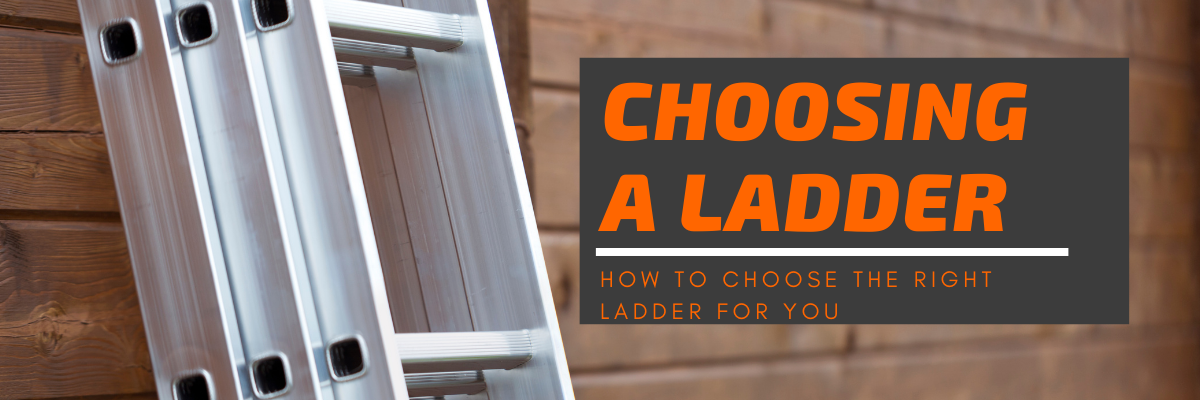Choosing the right ladder can be a minefield, with many people not knowing one type of ladder from another. Using the proper ladder for the job is the safest way to complete any task, lowering the risk of serious or even fatal injury.
There are a few factors to consider to help you make the best decision:
Selecting The Type Of Ladder
This is the first step in determining which ladder is best for you. Each ladder type is designed with a specific purpose/task in mind and thus has a unique set of safety features to keep you safe while climbing or standing on the ladder. Using the incorrect type of ladder or failing to understand its limitations can result in serious injury.
The most common types of ladders are:
- Step Ladders
- Combination Ladders
- Telescopic Ladders
- Podium Steps
- Work Platforms
- Roof Ladders
- Extension Ladders
- And Loft Ladders
For instance, you could have a step ladder with adjustable feet for use on uneven terrain or handrails for safer climbing.
How To Select The Right Ladder Height
Regarding the height of your ladder, there are some rules you should follow.
The highest acceptable standing level on a swing step ladder or an extension ladder is three steps down from the top. As the three rungs above you act as leaning support.
Whereas with a platform step ladder the user is able to stand on the top platform because it has a large handrail that provides support while working.
The maximum working height estimates how high a person can reach while standing on the highest recommended tread. Because it is calculated by adding 1.5m to the height of the safest tread, this calculation is an estimate (the height of the average person). To get a more accurate figure, subtract 1.5m from the specified height and add your height on top.
How Much Weight A Ladder Can Hold
Every ladder is built to withstand a certain amount of weight. This figure refers to the user's total weight when fully clothed and carrying any additional materials or tools. Every ladder that is certified to the EN131 standards (which came into effect January 1st 2019) has a max weight limit of 150kg.
Ladder Standards
Each ladder is also built to withstand different levels of use. This will fall under EN131 Professional and EN131 Non-Professional for ladders in general.
The EN131 Professional standards have replaced the old Class 1 standards and are intended for industrial and commercial applications.
EN131 None Professional is only covered for domestic use and should not be used on any kind of worksite or if you are a trade coming into people's homes. This is due to the different levels of testing the ladders must go through.
An EN131 Professional ladder has undergone twice as much ladder testing to ensure that it is safe for regular use.
Selecting The Right Material
Ladders are made from a variety of materials, the most common of which are aluminium, fibreglass, and wood.
Aluminium ladders are lightweight but durable. The weight of the ladder makes it easy to transport, and it is light enough for one person to handle. Aluminium ladders are rust and corrosion-resistant.
Steel is heavier and more difficult to move, but it is extremely durable.
You must use a Fibreglass ladder if you are working with or near electricity. Fibreglass ladders are well-known for their strength, durability, and, most importantly, their non-conductivity to electricity. They may weigh slightly more than aluminium however fibreglass ladders are extremely strong and tend to last longer.
Timber ladders are significantly heavier and cannot be stored outside because they split and rot more easily in wet conditions. Because fibreglass, like wood, does not conduct electricity, it can be used for electrical work. When it comes to choosing a Loft Ladder, timber is still a popular option. This may be due to the fact that timber ladders are both aesthetically pleasing and durable.
Loft Ladder Material
There are numerous factors to consider when selecting a loft ladder. Both wood and aluminium ladders have advantages and disadvantages, but both are long-lasting and dependable options.
For those who live in a traditional, cosy home and want to keep their loft ladder in line with the theme. Then a wooden loft ladder is ideal. They are also ideal for people who require a strong option. The wood can also withstand heavier objects and daily use better than an aluminium loft ladder.
Aluminium ladders, on the other hand, are better suited to those looking for a lightweight and safe ladder for easy and safe access to the loft.
Conclusion
If you have any further questions about which type of ladder would be best for the working at height task that you need to complete, please contact us at 01204 590 232 and we will gladly advise you as best we can.

